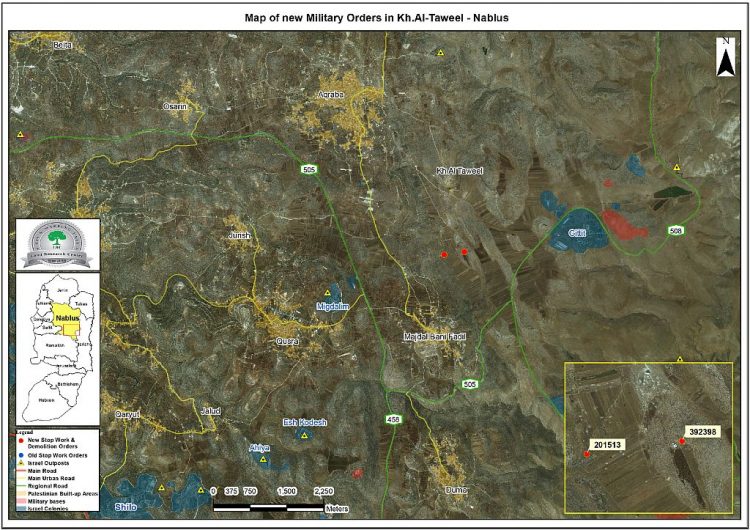Under the title “Administrative Process: Expropriated land included in Plan to build 640 housing units in the settlement of Eli”, a report published to reveal information about the petition filed by the Palestinian villages council heads of As-Sawaya, Lubban Ash-Sharqiya and Qaryut, with Bimkom- Planners for Planning Rights and Yesh Din, the petition demanded the Israeli Supreme Court to prevent the Israeli Civil Administration from approving a detailed master plan for the Israeli settlement of Eli. According to the petition, 221 dunums (22 % of the total area of the plan) not declared as “State land” are included in the settlement plan. Their inclusion in the settlement plan effectively expropriates these lands, without public announcement or right of appeal, gravely violating the rights of residents of the neighboring Palestinian villages (As-Sawaya, Al-Lubban Ash-Sharqiya and Qaryut). The petition also, demanded the Israeli Supreme court to order the Israeli Civil Administration to halt all new construction and refrain from granting construction permits in the plan area. It’s important to mention, that many of housing units in the plan area have already been built.
map No.1: the expansion plan of Eli settlement
During the analysis done by the Applied Research Institute – Jerusalem (ARIJ), for the expansion plan of Eli settlement and aerial photos, showed that the plan which hold No. 237 and seeks to expand the Israeli settlement of Eli by building 640 new housing units, located inside the border of the settlement, but the problem is, that there are parts of land inside the plan area are not classified as “State land”. Also the analysis showed that the area of the expansion plan of Eli settlement to build 640 housing units reach to 1046 dunums and there are 252 dunums of land (24% of the total plan area) never declared as “State land”. The aerial photos showed also, that many housing units have already been built illegally prior to the plan area, which means that the construction process came before getting the approval from the Israeli Authorities, this is in addition that a number of these housing units build on land are not classified as “State land”. It’s important to mention that the Israeli Occupation Authorities claimed that all the Israeli settlements are legal if they are built on land owned by the Israeli Authorities, in other words land classified by the Israeli Authorities as “State land”, and if some of the housing units in Israeli settlements build on land not classified as “State land”, the Israeli Authorities gave them the permits they needs, in illegally ways, and away from the eyes of Palestinians and international organizations. This what was proved during the years of the Israeli Occupation, and also was proved on the ground, when the Israeli Occupation Authorities demolished Palestinian houses and structures under the claims that the houses have been built in illegal ways, but when the Israeli settlers build houses and structures without permits and in illegal ways, the Israeli Authorities directly authorized these buildings.
The expansion plan of Eli settlement, done by the Israeli Civil Administration, showed that Israel seek to annex open public area to the expansion plan No. 237, this area are land occupied by the Israeli Authorities and classified as “State land”, but the Israeli Authorities keep its status as “open public area”, to use them later on to expend settlements or to build new ones. In the expansion plan of Eli settlement case, the plan included an area classified as “open public area”, which on February 2013, the Israeli Authorities published an ad in the local newspapers, announcing the depositing of plan no. 237 for 620 housing units in the settlement of Eli, by changing the status of the land from open public area to residential area. [1]
The illegal settlement of Eli:
Eli settlement occupied Palestinian land at the southern part of Nablus city, and mediates the Palestinian villages; As-Sawaya, Lubban Ash-Sharqiya and Qaryut. The illegal settlement of Eli established on the year of 1984, and occupied 3318 dunums of Palestinian land, while the area of the master plan for the Eli settlement, which done by the Israeli Authorities in 1991, reach to 3835 dunums. According to settlers population in 2011, there are about 3259 Israeli settlers lives in Eli settlement.
To conclude:
Whatever are the Israeli ways to control over the occupied Palestinian territories and build the Israeli settlements, it remain illegal, and grave the International laws and norms.
- The confiscation and destruction of Palestinian land is a violation of the Fourth Geneva Convention, Article 147 of which clearly prohibits, ''extensive destruction and appropriation of property, not justified by military necessity and carried out unlawfully and wantonly.'' Violations of Articles of the Fourth Geneva Convention constitute breaches of the Convention and should be prosecuted as War Crimes.
- United Nations Security Council resolution 446, adopted in 1979, concerned the issue of Israeli settlements in the " Palestinian territories of the West Bank, East Jerusalem and the Gaza Strip. In the Resolution, the Security Council determined: "that the policy and practices of Israel in establishing settlements in the Palestinian territories occupied since 1967 have no legal validity and constitute a serious obstruction to achieving a comprehensive, just and lasting peace in the Middle East"
- United Nations Security Council resolution 465 (1980), demanded Israel to dismantle the existing settlements and stop the planning and building of the settlements in the occupied Palestinian territories, included east Jerusalem.











